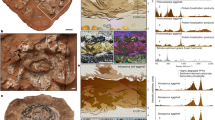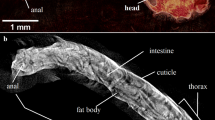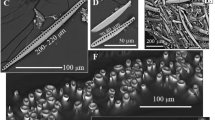Abstract
MANY epithelial cells are known to regulate the flow of water and ions across the epithelium. This has been observed in various animals1 and is probably an essential feature of all living organisms. Hibernating Otala lactea (Mollusca, Gastropoda, Pulmonata) can survive long periods of drought without access to water by regulating the evaporative water loss from the mantle epithelium2. Machin2 has shown that these snails are as efficient as insects at controlling water loss when they are hibernating, yet when they are active and crawling they lose water at the same rate as does a free water surface. To achieve this the animals produce an osmotic gradient across the mantle epithelial cells of approximately 4.5 Osm kg−1 from the cell base to the apical plasma membrane2. X-ray microanalysis of freeze-dried frozen sections has shown that the levels of silicon, chlorine, potassium, iron and zinc are significantly greater in hibernating (regulating) mantle tissue than in tissues taken from normal actively crawling snails, and a gradient can be observed within these cells.
This is a preview of subscription content, access via your institution
Access options
Subscribe to this journal
Receive 51 print issues and online access
$199.00 per year
only $3.90 per issue
Buy this article
- Purchase on Springer Link
- Instant access to full article PDF
Prices may be subject to local taxes which are calculated during checkout
Similar content being viewed by others
References
Keynes, R. D. Q. Rev. Biophys. 177–281 (1969).
Machin, J. Science 183, 759–760 (1974).
Gupta, B. L., Hall, T. A., Maddrell, S. H. P. & Moreton, R. B. Nature 264, 284–287 (1976).
Russ, J. C. in Electronmicrosopy and Cytochemistry (eds Wisse, E., Daems, W. T. & van Duijn, P.) 223–228 (North Holland, Amsterdam, 1974).
Appleton, T. C. J. Microsc. 100, 49–74 (1974).
Appleton, T. C. in Analytical and Quantitative Methods in Microscopy (eds Meek, G. A. & Elder, H. Y.) (Cambridge University Press, in the press).
Baker, J. R. J. & Appleton, T. C. J. Microsc., 108, 307–315 (1976).
O'Dell, B. L. & Campbell, B. J. in Comprehensive Biochemistry (eds Florkin, M. & Stotz, E. H.) 179–266 (Elsevier, Amsterdam, 1971).
Newell, P. F. & Machin, J. Cell. Tissue Res. 173, 417–427 (1976).
Author information
Authors and Affiliations
Rights and permissions
About this article
Cite this article
APPLETON, T., NEWELL, P. X-ray microanalysis of freeze-dried ultrathin frozen sections of a regulating epithelium from the snail Otala. Nature 266, 854–855 (1977). https://doi.org/10.1038/266854a0
Received:
Accepted:
Issue Date:
DOI: https://doi.org/10.1038/266854a0
This article is cited by
Comments
By submitting a comment you agree to abide by our Terms and Community Guidelines. If you find something abusive or that does not comply with our terms or guidelines please flag it as inappropriate.



